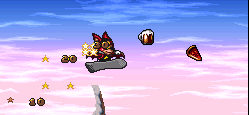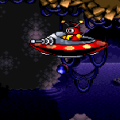- Aero the Acrobat
- Aero The Acrobat 2
- Zero the Kamikaze Squirrel
When we last left Aero, he had just attempted cold blooded murder on the evil Edgar Ektor, sending him hurtling towards his death. At the last moment, however, Ektor’s henchmen Zero the squirrel swoops in to save him, the crashing sound Aero heard actually being Ektor’s flying machine. Aero explores Ektor’s museum further, finding a magician’s box that sends him into an old castle. In the meantime, Ektor prepares to unleash “Plan B”. As it turns out, “Plan B” is to put a bunch of clowns on a train, ride around the country with them, and try his failed master plan again on all the circuses. While platformer villains aren’t really known for their creativity, he could at least stop claiming he invented what’s just a train. Even if he did put a cool skull on its front.
This time around, the game features cutscenes with various still images to tell the plot. Truthfully, it doesn’t really need one – Aero spends most of the game being dragged from place to place until he essentially stumbles upon Ektor’s plan. The game throws out a bunch of new characters without really introducing them, like a sultry lady bat, a stereotypical German mad scientist, and a band Aero is apparently a part of. It feels more than a little like the tie-in for a cartoon that doesn’t exist, but the creators had probably been hoping for. Even stranger, the writing often has a very simple style of writing that at times feels like it’s scripted for very young children.
The major mechanics have all been carried over from the previous game, with the addition of a downwards drill attack useful for hitting enemies directly below you, as well as certain weak spots in the ground. A nice quality of life change is that when you hit most enemies with your drill attack, you can now immediately perform another, preventing the way most enemies in the original game would hit you after you hit them. What hasn’t made it is the hover move from the original game, which let Aero pause mid-air for about a second. Since you weren’t able to move with the hover, it was rarely useful, and its absence isn’t especially missed.
Aero also has a slide move primarily used for going through low passages, performed by pressing down together with the look button while you’re running. Unfortunately, it’s not very useful for much else. On top of that, it’s not a very intuitive move to figure out without the manual, which can make the points mid-game where it’s required for progression somewhat frustrating until you stumble into what you’re supposed to be doing.
What has changed is the removal of any level objective that isn’t making your way to the exit, meaning levels are now much more linear. There’s still plenty of secret areas to look out for to gain lives, stars, and health, perhaps even more so than the original game. The general path through the level is pretty direct, however, and it’s rare you’ll end up lost. While having to scour the level for that last hoop was frustrating at times, the lack of objectives does remove what helped the first game to feel unique among all its many competitors.
No, playing Simon does not count as an objective.
While there’s nothing inherently wrong with making the game into a more focused, traditional platforming experience, there’s a lot lost in the transition. In the original game, you never quite knew for sure what would be coming next, whether it’d be a reflex-heavy gimmick stage or something that required you to go exploring. Here, almost every level is almost standard platforming. On top of that, while each of the worlds have three to four stages each, you’ll have seen everything they have to offer in terms of new obstacles and features halfway through them. After you reach that point, everything else for the rest of the world feels like more of the same, which can be somewhat of a slog.
On top of that, the game is far, far easier than the sometimes crushing difficulty of the original Aero. Making the sequel easier was far from a bad idea, given how difficult even reaching the end of the original’s first world could be. Unfortunately, things have moved somewhat too far in the other direction. In the process, combined with the lack of novelty in the level design, the game can get a little dull. One unambiguously positive change however, is that the game now offers passwords between worlds. While it’s unlikely you’ll need to use them from running out of continues, the game can drag enough that the chance to take a break is more than welcome.
“Alter Aero” isn’t very likely to surpass Metal Sonic in terms of rivals any time soon.
Almost all the instant-death hazards have been removed, and while there’s plenty of spikes and similar hazards, these will only cost you a single health point. There’s a few traps, such as pits, clanging bells and whirring fans that will kill Aero, but all of these can be avoided fairly easily. Health pickups are also more common, to the point where you’ll find the occasional box that spits out an infinite supply, which means it’s a lot easier to tank hits until you get through a tough section. Secret areas hiding extra lives are just as common, which means it’s generally not too difficult to keep the counter in the double digits. You’re also now rewarded extra lives for clearing a level of enemies, stars, and food, which usually isn’t too hard to do if you take your time.
Also hidden within each level are four letters spelling Aero’s name, a common practice of platformers all the time. Finding them all will let you enter “Ektor’s Deal” at the end of the level, a cup game that gets harder the further the game progresses. Guessing the right cup will earn you another life, which quickly stacks up with the others you’ve gotten. You also get to look at Ektor’s giant floating clown head as it bids you welcome in a deep, booming voice. Given how soft and fluffy the rest of the game is, it’s surprisingly unnerving.
You might wonder why he’s helping you, but this is nothing compared to the way he stops to give you health pickups during the final boss battle.
Unfortunately, the platforming throughout the game is pretty basic, and doesn’t really feel like it gets drastically more difficult or interesting at any point. Gone are the points where you’d suddenly find yourself bungee jumping to grab items and avoid spikes. You’ll find barely any circus equipment that you’ll have to figure out how to use to get to where you’re going. You’ll use a cannon a handful of times to launch yourself upwards, but that’s about it. There’s a couple of original ideas, such as invisible blocks that shimmer for a moment when you land on them, but the game doesn’t do as much with these as they could.
The worlds you’ll travel through also don’t have the same consistency – in the original game, it felt like more of a journey to the end of the game, one place mostly logically leading to the next. Here, you’ll suddenly end up in a music-themed level as was popular at the time, where you fight disco clowns and have to play a Simon minigame to leave the level. The reflex-heavy vehicle sections have been moved to their own set of three levels where Aero takes to a snowboard, in cool 90s mascot fashion, but even these just aren’t challenging enough to be interesting. The hardest the game gets is its final stage, an autoscrolling section atop a train where the bombs sending shrapnel in hard to dodge arcs and lack of health pickups actually cause some real concern.
If there’s been any improvement made, it’s definitely been in the visual department. The levels look far less ‘tiled’ then they were before, with more natural looking scenery that helps the locations look a little more ‘real’. The only real exception to this is the music stage, where lava lamps and music are scattered haphazardly around the level to be used as platforms, topped off with a distracting, constantly shimmering pattern the background. The characters also have far more animation than they did before, with Aero himself having so many frames in his movement that it’s only a step below games like Earthworm Jim. While the enemies aren’t quite as smooth, the game offers far more in terms of their variety. You’ll find clown monks in the castle world, and ushanka-clad hedgehogs who roll themselves into snowballs in the Russian fortress stages.
In terms of music, the game has lost its bombastic, circus-style soundtrack in favor of music that’s generally softer and at times, a little more atmospheric. It makes sense, given the new locations you’ll be traveling through, even if it’s another game somewhat lacking the original game’s style. Unfortunately, while all the music is general, there’s not much to call out, aside from the funk-style tracks that play all throughout the disco world. Aero himself also vocalizes a lot more, which while not terribly annoying at first, can get a bit grating if you play for too long.
The SNES & Genesis versions have some minor aesthetic differences, although nothing quite interesting enough to make either version definitive. The SNES version offers some extra graphical effects like transparent fog that the Genesis lacks, while some levels on Genesis take place at different times of day. For some reason, Aero’s death animation also differs between versions – on SNES, he turns into an angel, while on Genesis, he flies off in an arc much like the original game. The Genesis version also features a few different sound effects, as well as new music tracks that replace where tracks were reused on SNES. This includes the final stage, which somewhat anticlimactically reuses a song from the second world on Super Nintendo.
On its own merits, Aero 2 is a decent platformer, even if it doesn’t do anything particularly special compared to more famous games on either of its systems. Compared to the original game, it should theoretically be the better game, with more focused level design and an easier difficulty. Despite that, it just doesn’t really have what made that game stand out, and it’s just a little weaker for it. It’s a functional game, but one that quickly, and somewhat deservedly, got buried in an avalanche of more ambitious games.


